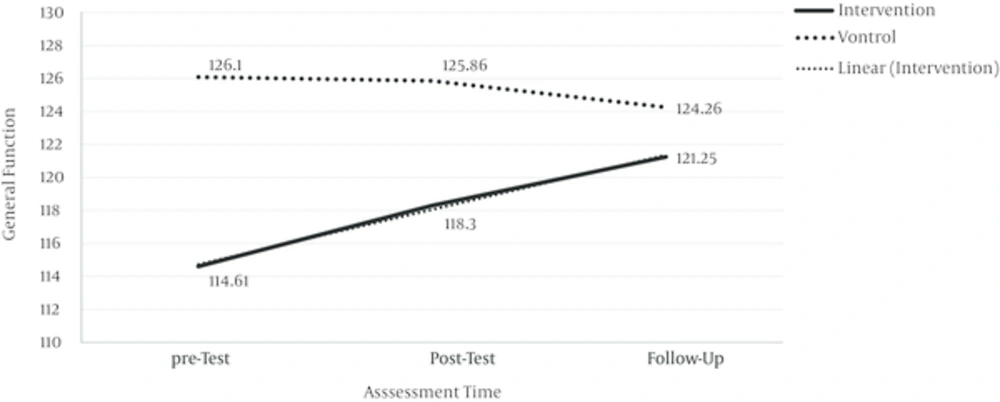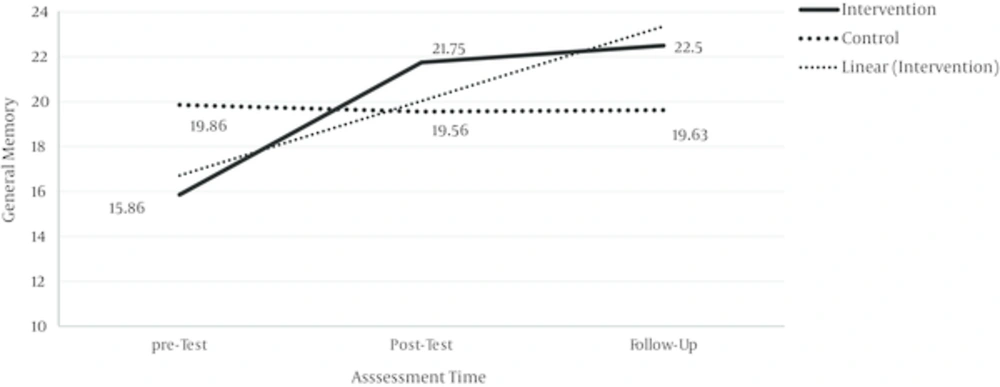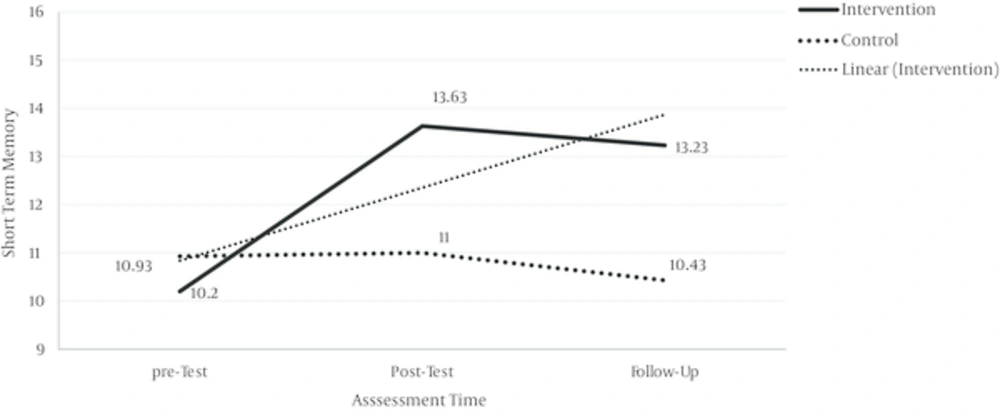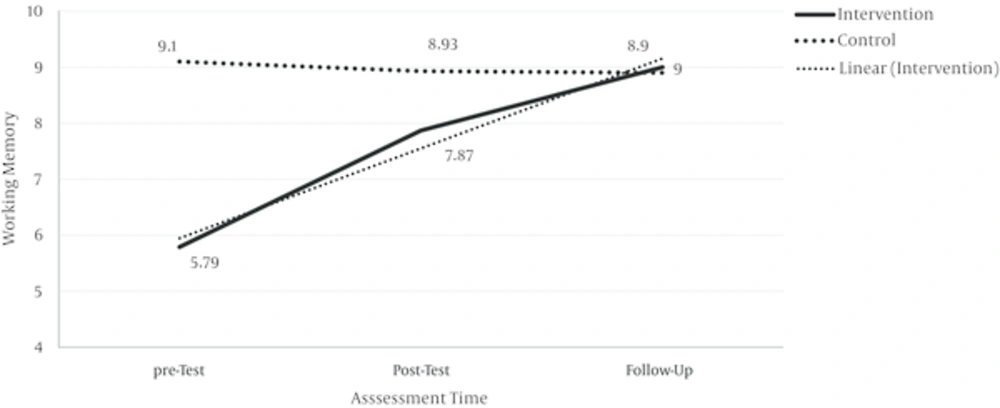1. Background
Cognitive skills such as intelligence and memories have the main role in educational achievement (1). Neuropsychological training probably concentrates on achievements instead of educational intervention (2, 3). Training can even improve neuroplasticity of the brain to promote or recover other cognitive skills (4). Besides, some well-performed cognitive abilities can help other skills get better (3). Among cognitive skills, working memory (WM) is more important because it is a basis for human thoughts processes like education and executive systems (2, 5). Baddly and Hitch (1974) introduced the concept of working memory. According to their ideas, WM is a three-component model, which includes visuospatial sketchpad, central executive, and phonological loop (5-7). Meantime, phonology and vision are more important than sounds and meanings. Thus, cues are stored at WM in a short time to retrieve data when it is necessary. For example, the first and last items act as cues in this context (5). The more capacity of WM is, the higher-order cognition across a wide range of conditions will be. WM improves and facilitates the efficacy of decision making (8), short-term memory (STM), execution functions, reasoning, learning, comprehension (2, 5, 6), comparison, verbal fluency (9), attention (2), general fluid intelligence (Gf) (7), etc. Indeed, WM as the space of mind acts like the capacity for other cognitive skills that comes and uses goal-relevant information as needed to support complex cognition. If you improve working memory, other skills such as Gf will get better (7). Except processing speed, main cognitive skills like primary memory, WM, and Long-term memory can be predicted by Gf because it utilizes other cognitive skills. Thus, neuropsychological training not only helps attain educational objectives, but also improves neuroplasticity of the brain. Working memory training changes the brain activity of frontal and parietal cortex, basal ganglia, and density of dopamine receptors because it is not an isomorphic construct (2). Indeed, training improves neural connections, white matters density, cortical thickness, etc. These improvements help the brain use less energy and work faster, which are the signs of intelligent improvement. Conclusively, intelligence could be mature based on how the individuals use their cognitive skills for intelligent performances (3).
For training, we need to specify our training approach. In specifying training approach, the first one is experimental, and the second is an active control. The former depends on learning strategies over time, while the latter suggests that all stimuli could be useful and we cannot determine special stimuli for cognition improvements. Therefore, if you stimulate senses, cognition will improve. Generally, they suggest that learning and stimulating sensory systems, even through regular exercises, can improve the plasticity of the brain (1 hour a day, 5 hours a week, for 8 weeks) (10). Likewise, WM training is divided into two types, explicit or implicit. If the tasks are based on repetition, feedback, and gradual adjustment of difficulty, they are implicit tasks, which are supposed to improve perceptual-motor training. Passive systems like n-back do not have influences on the efficacy of cognitive skills like WM or short-term memory (STM) because they are scales to evaluate frontal lobe performances (5). On the other hand, conscious plans for handling the material of WM are explicit trainings, focusing on visuospatial stimuli. It could be a teaching strategy to improve performance in WM tasks like rehearsal, meta-cognitive plans, and chunking (2).
Dual tasks like dual N-back, as a computerized task, can update memories and they are active control and implicit task. Likewise, dual n-back is a visuo-auditory task, activating prefrontal cortex, precentral gyrus, parietal lobe, and caudate nucleus, and hence it improves capacity of WM (2, 11). There is a neural network of fluid intelligence, referring to reasoning and novel problem, and working memory,” the active maintenance of domain-specific information plus domain-general attentional or executive control of ongoing processing” (12). Therefore, the task is far likely to improve working memory due to attention improvement (11). Although some studies indicate that it has a limited effect that does not significantly last more than 20 days, an attention improvement following dual n-back training considerably could be achieved through working memory improvement (12).
Finally, participants should recall longer list, not change the number of items. The optimum time for WM improvement is 45 minutes per session, 3 times a week, for 5 weeks (11 hours) (2); it is a suitable task for collective training. In fact, the training is economic, could improve student’s motivation to do the task well, and could solve the limited effect of dual n-back in WM, STM, and Gf. Indeed, former studies could change WM and Gf, but the practice effect is not long-lasting. So, we tried to improve the effect of Dual N-back training because human is a social creature and they are likely to do cognitive tasks well when they are in a group.
2. Materials and Methods
It was a quasi-experimental study using a random sampling method. In accordance with former studies that used sample size of about 70, this study was conducted on 66 female participants. We performed the study in four classes of a middle school for four months in 2015 in Hamadan. Two classes were allocated to the experimental group and two others to the control group. The study participants were middle school students. Sixteen subjects were thirteen years old and twenty were fourteen years old (Mean = 13.48, SD = 0.50, in range of 13-14 years).
The mean of general average of the first semester of experimental (N = 36) and control groups (N = 30) were replicated. We trained the experimental group in twenty four sessions, but the control group did not receive any training using the dual n-back task. The data were analysed by Chi-squares, independent t-tests, and repeated measure ANOVA in SPSS 22. Finally, it is worthy to note that it was an interventional study.
2.1. Procedure
Initially, the ethical committee of the ministry of education of Iran approved the study, and allowed the corresponding author to begin the study. Next, the participants’ parents was asked to sign the informed consent form because the subjects were under aged. This was performed only for the students volunteered to participate in this study. All of the participants were assessed in the pre-test. All the used tests had face validity and acceptable test-retest reliability. The fluid intelligence, working memory, and short-term memory of subjects were assessed using Wechsler’s memory subtest and Raven’s progressive advanced matrices (RAPM), respectively. Wechsler’s memory subtest is administered under the conditions that first, examinees read a series of numbers and second, they must repeat them inversely. Raven’s progressive advance matrices has 60 items whose difficulty level increases for subsequent questions. Students in the experimental group were trained during 12 sessions twice a week. Each session lasted 45 minutes. There were a 60-day interval between pre- and post-test stages and 30-day interval between post-test and the follow up test. Jaeggi claimed that the more the training is, the more the achievements will be because it is a dosage-related training. Thus, improvements can be observed after a 17-day training period (13). We asked participants not to practice at home because we could hardly control the quality of self-training. Also, we wanted to assess only the influence of collective 12-session training. Participants in the control group neither attended training sessions nor knew the main purpose of the study. Meanwhile, the subjects were motivated to accomplish the tasks correctly. The training employed in the present study was based on the dual n-back task (13). It has been developed by Susanne Jaeggi since 2003 in order to compare load-dependent processing in single and dual tasks. This method is currently used for cognitive neuropsychological rehabilitation tasks. In the dual n-back task, a series of blue squares are flashed on the screen at one of the eight different locations randomly and the letters are simultaneously presented via an audio output. Each combination of stimuli presents for 500 ms, and the interval time between two stimuli is 2500 ms. Subjects ought to press the “A” key if the location of the present square matches the position N stimuli earlier and the “L” key provided that the letter currently is heard is the same as the letter heard N stimuli before. Indeed, dual n-back task was designed by Sussan Jaeggi to adapt user’s performance to remain challenging to the user. The program increased the difficulty level of the task to N + 1 if the participant could correctly recognize matched stimuli in both signals with more than 90% success rate and if it was less than 70%, the program decreased the difficulty level of the task to N - 1. Meanwhile, when the person did not include in neither of the two conditions, the level would not change. Sussan Jaeggi indicated that the capacity of WM and Gf could be improved according to users’ performance.
The Cronbach’s α coefficient values of fluid intelligence, general memory, working memory, and short-term memory in the current study were 0.95, 0.91, 0.85, and 0.87, respectively. Next, all of the participants completed post-test and follow-up test. Fluid intelligence, working memory, and short-term memory were assessed using aforementioned tests under the same conditions as the pre-test.
Chi-squares and independent t-tests were performed to identify possible differences in demographic variables between the intervention and control groups. Demographic variables are presented in Table 1.
| Cognitive Rehabilitation Group (N = 36) | Control Group (N = 30) | Statistical Analysis | |
|---|---|---|---|
| Educational level (second grade/third grade) | (19 / 17) | (14/16) | χ2(1) = 0.24 n.s. |
| Age in year (S.D) | 13.44 (.50) | 13.53 (.51) | t (64) = 0.48, n.s. |
| Great point average | 18.94 (1.13) | 18.86 (1.18) | t (64) = 0.79, n.s. |
Comparisons of Demographic Characteristics across Groups
The results of pre-test, post-test, and follow-up test were compared in order to understand the efficacy of collective dual n-back training in fluid intelligence, working memory, and short-term memory.
3. Results
3.1. Preliminary Analysis and Statistical Strategy
Comparison of demographic characteristics between the groups confirmed that the groups are match based on age and gender. Repeated measures ANOVA was conducted to test differences between the neuropsychological treated group and control group in terms of fluid intelligence, general memory, short-term memory, and working memory. The groups (neuropsychological treated vs. control) were assessed as between-subject and time series data (in pre-test, post-test, and follow-up) were tested as within-subject. The two groups were similar in short-term memory but not in fluid intelligence, general memory, and working memory in pre-test (see Table 2 and Figures 1 - 4). The significance of between-subject was confirmed by within-subject interaction effect (TIME*GROUP) (P < 0.01). Consequently, a within-subject effect (TIME) using repeated measures ANOVA was run in both neuropsychological treated and control groups, with post hoc pairwise comparisons of pre-test, post-test, and follow-up scores (see Table 2). Independent t-test was then performed for baseline, post-intervention, and follow-up comparisons between neuropsychological treated and control groups to assess group differences in fluid intelligence, general memory, short-term memory, and working memory before and after neuropsychological treatment intervention. The results were controlled for age, gender, great point average, and educational level as covariate variables in the model to control the differences in cognitive factors attributed to demographics. Short-term memory is a limited holding capacity for information. Working memory is the cognitive system that allows one to store and manipulate a limited amount of information over a short period, and its functioning is essential for a wide range of complex cognitive tasks, such as reading, general reasoning, and problem solving” (14).
According to Figure 1, the collective dual n-back training promotes fluid intelligence.
| PR/PO/FO-Mean | TIME | TIME*GROUP | Within-Subjectb | Post Hocc | ||
|---|---|---|---|---|---|---|
| GF | Intervention | 114.61 / 118.30 / 121.25 | F(1, 64) = 6.25,P = 0.001, η2 = 0.089 | F(1, 64) = 18.30, P = .001, η2=.22 | F (1, 35) = 17.82, P = 0.001, η2= 0.34 | PR < PO**; PR < FO**; PO < FO* |
| Control | 126.10 / 125.86 / 124.26 | F (1, 29) = .3.52; P = .82, η2 = .11 | PR = PO; PR = FO, PO = FO | |||
| General memory | Intervention | 15.86 / 21.75 / 22.50 | F (1, 64) = 60.76, P = 0.001, η2= 0.49 | F (1, 64) = 69.94, P = 0.001, η2 = 0.52 | F (1, 35) = 102.97, P = 0.001, η2= 0.75 | PR < PO** PR < FO** PO < FO** |
| Control | 19.86/19.56/19.63 | F (1, 29)= 0.28, P = 0.23, η2= 0.01 | PR = PO, PR = FO, PO = FO | |||
| Short-term memory | Intervention | 10.20 / 13.63 / 13.23 | F (1, 64) = 19.98, P = 0.001, η2 = 0.23 | F (1, 64) = 39.84, P = 0.001, η2 = 0.38 | F (1, 35) = 41.04, P = 0.001, η2 = 0.54 | PR < PO** PR < FO** PO = FO |
| Control | 10.93 / 11.00 / 10.41 | F (1, 29)= 0.13, P = 0.72, η2 = 0.004 | PR = PO, PR = FO, PO = FO | |||
| Working memory | Intervention | 5.79 / 7.87 / 9.00 | F (1, 64) = 21.42, P = 0.001, η2 = 0.25 | F(1, 64)= 27.49, P = 0.001, η2= 0.30 | F (1, 35) = 35.81, P = 0.001, η2= 0.51 | PR < PO** PR < FO** PO < FO** |
| Control | 9.10 / 8.93 / 8.90 | F(1, 29)= 0.43, P = 0.001, η2= 0.001 | PR = PO, PR = FO, PO = FO |
Linear Repeated Measures ANOVA for GF, General Memory, Short Term Memory, and Working Memory Following the Cognitive Rehabilitation Interventiona
According to Figure 2, the collective dual n-back training increases general memory, which remains stable in follow-up.
According to Figure 3, the collective dual n-back training promotes the short-term memory, which remains stable in follow-up.
According to Figure 4, the collective dual n-back training progresses working memory, which remains stable in follow-up.
Following the significant interaction effect (TIME*GROUP), the result of within-subject effect (TIME) in repeated measures ANOVA confirmed the increasing trend from time-1 to time-3 assessment points in fluid intelligence, general memory, short-term memory, and working memory in cognitive rehabilitation receiving group compared with control group (Table 2; Figure 1 to 4).
4. Discussion
In agreement with Gray, Thomson, and Klinberg studies, this study showed that dual n-back task training significantly improved the capacity of middle school students’ working memory in a collective training. This was because working memory improves the performance in a wide range of functions, neural change of intercellular levels to functional organization of the cortex, synaptic connectivity in motor and sensory areas, and plasticity of frontoparietal cortex that are related to functional representation of WM, Gf, and attention (2, 4, 15). In other words, dual n-back tasks empower the prefrontal lob activation, which is responsible for remaining and transferring information. Interestingly, the effect of phonological similarity, which is in the marker of phonological loop, is far likely to be robust in WM because phonological loop gets more attention compared to the visuospatial (5). Besides, the improvement does not relate to shapes and sizes of visual stimuli, except for Gabor stimuli (7). Surprisingly, phonological loop and visuospatial sketchpad could not bind because they have no way to connect to each other. As a result, attention has an execution rule for both WM and dual n-back (5). Meanwhile, Ponds suggests that if you train WM regularly, it will be more and more powerful, whereas we suggest that training about working memory should be in a long period of time because of distributed practice (16, 17). Indeed, implicit tasks focus on updating replacement of old information with new one. Thus, the dual n-back task as a multi-sensory task employs auditory and visual senses and activates dorsal and lateral prefrontal lobe. In addition, the stability of cognitive training gets better than that has been reported in former studies because of a collective distributed practice (16). Conclusively, the task utilizes elements of WM such as holding, inhibition, and updating to improve WM although Gray and Thompson state that it is a temporary effect (4, 13, 17). Yet, no significant relationship has been found between the levels of dual n-back tasks and working memory because of insufficient sample size. Maybe, if the sample size increases, the levels of dual n-back tasks will be a suitable criterion to anticipate improvement of working memory (18).
Also, Gf improved with dual n-back tasks, as previously shown in Jaeggi’s study, but under normal circumstance, Gf could not be improved directly (7, 9). This is because Gf uses many skills like WM to assimilate, accommodate, practice, and group data well, and modifying cognitive skills can change the efficacy of Gf (9). Interestingly, if you see contradiction among information in long-term memory (LTM), they will enter to WM, so that Gf corrects them (19). Indeed, Gf is likely to make connections between data or the capacity of WM helps Gf process more or less information (9). The correlation between WM and Gf is because of a latent variation in long-term processes. Indeed, attention which is a latent variable of LTM is important for WM and if you control attention well, you will do Gf, WM, and LTM tasks well because WM and LTM have a common area that encompasses attention (19). In addition, the same neural network of both working memory and Gf are in Lateral Prefrontal cortex and Parietal lobe. Thus, when dual n-back improves WM, Gf will be improved simultaneously (14, 20). Besides, Parieto-frontal pathways contribute to intelligence differences and extrastriate cortex, fusiform gyrus, and Wernicke are far likely to contribute to IQ because they recognize images and sounds (3). Dual n-back is based on processing two tasks, auditory and visual, in the same time according to interference. In fact, the principle of dual n-back is on two tasks competition to use the same limited resource (7). Thus, the dual n-back task could improve Gf, as reported in Feiyue’s study, especially for 13-14-year old students whose Gf heritability has become stable. In fact, the brain morphology of intelligence depends on genes and three hundred genes are associated with intelligence. If genes are exposed to suitable stimuli, they will appear (4).
Besides, dual n-back tasks significantly improved STM, i.e. processing in sensory systems. The left temporoparietal area (BA 40) is for phonological STM (5). STM has a limited capacity and dual n-back tasks increased the capacity of STM. It is a multi-task and STM should hold data in order to transfer them to LTM if they are paid attention. In addition, the efficacy of STM is very sensitive to psychological conditions. Even, lack of sleep can affect STM and visual processing. Thus, cognitive tasks can have a direct influence on STM (1).
Interestingly, improvement of WM, Gf, and STM did not significantly have an influence on general averages in the experimental group in both pre-and post-tests. But former studies indicated that WM tied to educational achievements (1) and Johnston’s studies suggested that Gf had a correlation of over 0.8 with educational achievements (3). By the way, the insignificant relationship could be due to the content of the computerized cognitive neuropsychological rehabilitation tasks, which is limited by the generalization of effects over the ordinary life.
Moreover, a 30-day follow-up study implied that the effect of dual n-back training was stable although previous researchers such as Gray, Chabris, and Brave suggested that dual n-back training had a temporal effect (12). This contradiction is likely due to different research methods and participants’ motivation (4). Participants in this study were adolescent but not in the initial stage; Thompson claimed that the improvement could be due to development of cognitive skills rather than training. Meantime, heredity along with training can make dual n-back influence more stable (4). In fact, biology controls the range of talent, while behaviour and context determine the place of skill in the higher or lower range limits (21). Thus, not only the dual n-back task, but also other training methods have limitations if training continues for a long time because the pace of change is becoming lower and lower or insignificant (18).
Limitation and future directions: Studying cognitive skills such as memory and intelligence depends on various factors that intertwine with each other like nutrition, education, socio-economic level, motivation, and emotions. Thus, in order to understand the effect of these factors correctly, we should consider the main variables precisely (4). Gf plays a crucial role in educational achievement, occupational attainment, social mobility, job performance (3), Cognitive behaviour therapy (CBT) (22, 23), perceptual speed (9), etc. Therefore, designing a protocol for cognitive training on Gf in a suitable time, which is after age 13, is vital for cognitive psychology. The heritability of Gf at age 5, 7, 10, and 12 is 26%, 39%, 54%, and 64%, respectively, but in crystallized intelligence, it is vice versa (3). Meantime, WM training has a very important role in parallel processing, reaction time, psychotic patient treatment (24, 25), inhibitory functions, reasoning, psychotherapy, (2) and so on. Moreover, cognitive training changes the efficacy of other psychological treatment for psychotic disorders, attention deficit hyperactive disorder, traumatic brain injury, stroke, mental retardation, schizophrenia, Alzaimer, etc. For instance, drug-naive schizophrenic patients are slow, have low reaction time, and suffer from inability of parallel processing. The aforementioned problems are due to working memory problems as a result of frontal lobe impairment, so does not have neuroleptic treatment. Whereas, dual n-back training improves WM efficacy of psychotic patients like schizophrenics (24). Hence, the combination of cognitive psychology, clinical psychology, and educational psychology could bear satisfactory results.
Another limitation related to the participants’ gender that all were female in this study. However, it is well known that neuroscience of sexual differentiations of general intelligence is strongly correlated with fronto-parietal grey matter volume in males and white and grey matter volume in Broca’s area in females. Therefore, white matter integrity is far likely to be important in females than in males. As a result, generalization of the results of the current study to men should be performed cautiously. Also, it is difficult to identify the effect of neural activities on the improvement of attention, Gf, and WM, one by one.
Finally, sleeping time less than six hours could have an impact on cognitive skills like Gf, WM, and STM. However, the sleep time of participants was not checked (1).



